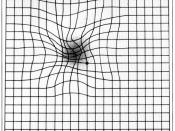Age related Macular degeneration, or AMD is an insidious, silent, progressive, degenerative slayer of sight. It is a disease that effects many elderly people above the age of 65. While AMD does not cause total blindness it does, however rob people of their ability to see all but peripherally.
In order to understand AMD, first, we have to understand the physiology of the eye. The eye consists of two lenses. The frontal lens, the cornea, is the most powerful. The weaker lens is known as the crystalline lens. The iris and pupil are in between the two lenses. The retina is a thin layer of tissue at the back of the eye, which is sensitive to light. The macula is one of three main parts of the retina. Its function is to define details clearly. The peripheral retina, and the optic disc are the other two retinal parts.
Photoreceptors are specialized cells that the retina relies upon to create vision. Cones and rods are represented throughout the retina. Photoreceptors are nourished by a series of extremely delicate blood vessels called the choriocapillaris.
Macular Degeneration occurs with the deterioration and death of the photoreceptors. While the cause of AMD is not completely understood, it is thought that the disease is caused by the lack of oxygen through the choriocapillaris to the macula.
When the process of Macular Degeneration occurs, the objects that one might see, seem less sharp or less well defined. The Retinologist upon examining the eye of a patient with AMD will notice whitish deposits called drusen within the retina and around the macula. Objects or items may seem imprecise and straight lines may appear bent.
There are two possible types of AMD, and one can be diagnosed with both. The first form of Macular degeneration...



Macular degeneration.
AMD ?
1 out of 1 people found this comment useful.